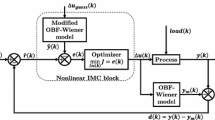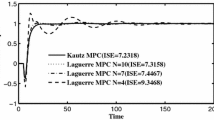Abstract
Resonating systems show oscillatory characteristics. System identification of resonating systems and design of their model based control strategy always draw special attention. This work presents a Wiener type system identification technique for nonlinear resonating systems. Orthogonal basis function (henceforth termed as OBF) is employed to capture the linear dynamic part of the Wiener structure while the static nonlinear mapping is described by two means, viz., wavelet decomposition and least squares support vector machine. Use of OBF leads to a parsimonious nature in the resulting nonlinear model. Two types of OBFs have been used in this work viz. Laguerre filter and Kautz filter. The Kautz filter has capability of modelling systems with complex conjugate poles. A case study has been performed with continuous stirred tank reactor (henceforth referred as CSTR) which is a reasonably nonlinear resonating systems. Degree of nonlinearity as well as resonance increases with series-connected CSTR. Simulations are carried out using \(\hbox {MATLAB}^\circledR \) software in order to evaluate the performances of various Wiener structures, and identify the OBF–Wiener model best suited for designing a model based controller.






Similar content being viewed by others
References
Henson MA, Seborg DE (1990) Input–output linearization of general nonlinear processes. AIChE J 36(11):1753–1757
Prakash J, Srinivasan K (2009) Design of nonlinear PID controller and nonlinear model predictive controller for a continuous stirred tank reactor. ISA Trans 48(3):273–282
Billings SA, Wei HL (2005) The wavelet-NARMAX representation: a hybrid model structure combining polynomial models with multiresolution wavelet decompositions. Int J Syst Sci 36(3):137–152
Glass JW (1999) NARMAX modeling and robust control of internal combustion engines. Int J Control 72(4):289–304
Patwardhan RS, Lakshminarayanan S, Shah SL (1998) Constrained nonlinear MPC using Hammerstein and Wiener models: PLS framework. AIChE J 44(7):1611–1622
Aadaleesan P, Miglan N, Sharma R, Saha P (2008) Nonlinear system identification using Wiener type Laguerre-wavelet network model. Chem Eng Sci 63(15):3932–3941
Alci M, Asyali MH (2009) Nonlinear system identification via Laguerre network based fuzzy systems. Fuzzy Sets Syst 160(24):3518–3529
Mahmoodi S, Poshtan J, Jahed-Motlagh MR, Montazeri A (2009) Nonlinear model predictive control of a pH neutralization process based on Wiener–Laguerre model. Chem Eng J 146(3):328–337
Saha P, Krishnan SH, Rao VSR, Patwardhan SC (2004) Modeling and predictive control of MIMO nonlinear systems using Wiener–Laguerre models. Chem Eng Commun 191(8):1083–1119
Wahlberg B (1991) System identification using Laguerre models. IEEE Trans Autom Control 36(5):551–562
Wang QC, Zhang JZ (2011) Wiener model identification and nonlinear model predictive control of a pH neutralization process based on Laguerre filters and least squares support vector machines. J Zhejiang Univ Sci C 12(1):25–35
Kautz WH (1954) Transient synthesis in the time domain. Trans IRE Prof Group Circuit Theory CT–1(3):29–39
Misra S, Reddy R, Saha P (2016) Model predictive control of resonant systems using Kautz model. Int J Autom Comput 13(5):501–515
da Rosa A, Campello R, Amaral W (2009) Exact search directions for optimization of linear and nonlinear models based on generalized orthonormal functions. IEEE Trans Autom Control 54(12):2757–2772
Zhang Q (1997) Using wavelet network in nonparametric estimation. IEEE Trans Neural Netw 8(2):227–236
Zhang Q, Benveniste A (1992) Wavelet networks. IEEE Trans Neural Netw 3(6):889–898
Vapnik VN (1998) Statistical learning theory, 1st edn. Wiley, New York
Suykens J, Vandewalle J (1999) Least squares support vector machine classifiers. Neural Process Lett 9(3):293–300
Goethals I, Pelckmans K, Suykens JA, Moor BD (2005) Identification of MIMO Hammerstein models using least squares support vector machines. Automatica 41(7):1263–1272
Totterman S, Toivonen HT (2009) Support vector method for identification of Wiener models. J Process Control 19(7):1174–1181
Wahlberg B (1991) Identification of resonant systems using Kautz filters. In: Proceedings of the 30th IEEE conference on decision and control, vol 2, pp 2005–2010
Daubechies I (1992) Ten lectures on wavelets. Society of Industrial and Applied Mathematics, Philadelphia
Falck T, Dreesen P, Brabanter KD, Pelckmans K, Moor BD, Suykens JA (2012) Least-squares support vector machines for the identification of Wiener–Hammerstein systems. Control Eng Pract 20(11):1165–1174
Huang Y, Lou H, Gong J, Edgar T (2000) Fuzzy model predictive control. IEEE Trans Fuzzy Syst 8(6):665–678
Author information
Authors and Affiliations
Corresponding author
Appendix: Detailed derivation of Kautz representation
Appendix: Detailed derivation of Kautz representation
Using Theorem 1 the state space Kautz model given in Eqs. (8) and (9) can be derived in the following state space form (q is shift operator).
where
Define the following states
Using Eqs. (73) and (74) in Eq. (70) one obtains
Similarly
Further
where
Define the following states
Using Eqs. (80) and (81) in Eq. (77), one obtains the regressors, similar to Eqs. (75) and (76) as
The derivation of regressors can further be continued and a generalized expression can be given as in Eqs. (11)–(16).
Further, upon applying inverse transformation on the Eq. (73) and thereupon using Eq. (74), following discrete time domain state space expression can be obtained
Similarly, upon applying inverse transformation the above Eq. (80) and thereupon using Eqs. (81) and (84)
Similar to Eqs. (80) and (81),
and applying inverse transformation on Eq. (88) and thereupon using Eqs. (89) and (86)
Likewise,
and
The above expressions in Eqs. (84)–(90), (91)–(95) can further be represented in a compact matrix form as,
and
where
and
and
and
The complete state space model can be derived as given in Eq. (20) whose \((2n-1)\)th row will be
and
Rights and permissions
About this article
Cite this article
Reddy, R., Saha, P. Modelling and control of nonlinear resonating processes: part I—system identification using orthogonal basis function. Int. J. Dynam. Control 5, 1222–1236 (2017). https://doi.org/10.1007/s40435-016-0277-3
Received:
Revised:
Accepted:
Published:
Issue Date:
DOI: https://doi.org/10.1007/s40435-016-0277-3




